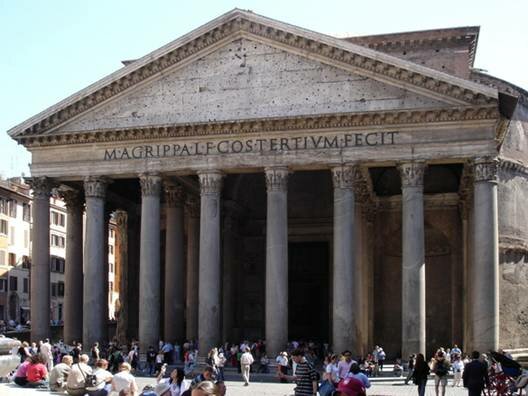Via della pineta Sacchetti, Roma-Italia-
Visit Roma
Authentication
Local Time
Sunday 4:43 AM
Pantheon
Đền Pantheon
POSTED IN: DU LỊCH ROMA - ITALY

The Pantheon is an architectural structure in Rome, Italy. The most prominent place in the history of the Roman temple and the world is the Pantheon – the “temple of all gods” built in 118-126 during the reign of King Hadrian. The form and size of the temple surpassed all the temples there were earlier.
Architecture
The building has a circular main block, a hemispherical roof roofed with a light stone. The roof diameter is 43.2 m, exactly the same as the building height. The magnitude of this hemisphere exceeds all types of domes of buildings made before and after almost 20 centuries (up to the nineteenth century). [1] The house wall is very thick (6.3 m) with many niches, arches in the lower part, but when it rises, it thins. From the bottom of the arch down the house is divided into 2 floors. The lower floor is 13 meters high using the final column coranh. The upper floor is 8.7 m high using only patches of bouncing walls made of marble. These bouncing wall plaques fit into one with 5 rows of flag cells that are recessed on the ceiling arch (called Millet) to create a feeling of lightness, relaxation. The roof arch is finished with a round hole of 8.92 m in diameter – a lighting solution that makes a very strong impression on people in a high space. Unlike the usual Greco - Roman temples (just the place where the statue is located), Pantheon with 1500m2 floor with entrance hall up to 14m deep has 16 circular columns 1.5 m diameter, 14m high, on the sloping roofing on both sides. Two rounded slopes on either side of the hall put the statue of the Emperor and the Statue of Marcus Agrippa – architect, engineer – friend of the Emperor. Another thing that makes a strong impression is that the temple front yard is up to 120m long, with columns and verandas surrounded. With a group of people coming in from far away, this porch at first obscured the massive building inside. Only after passing through the gate columns did the temple suddenly appear. With concrete materials, terracotta bricks and stone cladding, by clever and accurate calculations, the Pantheon deserves the pinnacle of ancient Roman technical thinking.
theo Wikipedia






